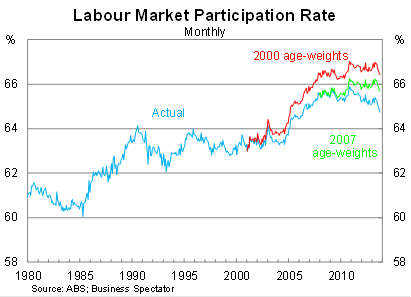Australia's irrevocable, inevitable growth challenge
Australia’s labour market participation rate has fallen sharply over the past few months and is now at its lowest level in seven years. But that pales by comparison with the expected decline resulting from ‘baby boomers’ retiring and the population ageing.
The participation rate – the share of working age population in the workforce – is a key measure of labour market and economic health. Since peaking towards the end of 2010, the participation rate has declined by 1.2 percentage points to be at its lowest level since October 2006. Part of this is a reflection of weaker labour market conditions, transitional industries and a non-mining sector that could generously be characterised as subdued. But there is also a longer-term trend pushing the participation rate down: an ageing population.

Separating the participation rate by age group identifies a variety of different trends.
Older people are more likely to be in the workforce than in previous generations; younger Australians have disproportionately felt the impact of a softening labour market; and rising participation by women has pushed up participation rates particularly through middle age.
The graph below shows that our preference for work changes as we age. Younger people have lower participation due to study, participation is extremely high between 25 to 54 years old and then people adjust their work-life balance as they head towards retirement. A change in the age composition of the Australian workforce clearly has implications; in this case, none of them are good.

Population data shows the effect of the ‘baby boomers’ on the age distribution of Australia. Generally the ‘baby boomers’ are assumed to be the generation covering 1946 to 1960, and we can see that group flow through the graph below. The 35 – 44 years old age group began to pick up in the early 1980s, as the first ‘baby boomers’ hit 35 years old. The same thing happened to the 45 to 54 years old age group a decade later. In 2011, the first of the ‘baby boomers’ hit 65 years of age and now that age group has begun to rise as a share of the total working age population.

As such a large share of the population, the retirement of the ‘baby boomers’ will cause the participation rate to decline. In fact, it already has.
How large is the effect so far? By holding the age group shares constant we can get an idea of what effect the ageing population has already had.
In the graph below I created two scenarios, by keeping the age-weights (from the graph above) unchanged from 2000 and also from 2007. The data suggests that the ageing population has lowered the participation rate by 1.7 percentage points since 2007; the gap will only continue to widen.

So why does this matter?
A lower participation rate affects most aspects of an economy, including growth, health care expenditure and government revenue. An economy’s output is a function of its resources (labour, capital, land, technology etc) and how those resources are utilised. An ageing population directly reduces the share of productive labour resources in the economy. It also reduces the tax base and GST revenues, given older Australians also consume a lower share of their income/wealth. Combined with rising health costs, the result is a government less able to provide the integral services that an ageing community requires.
And the issue is not isolated to Australia. It is a feature of most developed economies and even some developing economies such as China. The United States experienced a similar fall in participation, although they also have a larger economic component due to their recession. Japan has suffered from an ageing population for years, which – combined with low fertility and migration – has created a deflationary environment and a shrinking economy. The implication is a lower level of global economic growth.
The ABS produces population estimates based on Census data which can be used to estimate the future path for the participation rate. It should be noted that population growth estimates are extremely sensitive to small changes in fertility, mortality and migration rates. Nevertheless, the data provides some insight.
Assuming that the participation rate for each age group is unchanged (at their October 2013 level), the nationwide participation rate declines by a further 4 percentage points by 2030. In reality the decline will be less than that because the participation rate for older Australians will continue to rise and the retirement age will inevitably be increased. Consequently, I included an alternative scenario where the participation rate of people over 65 years of age increases to 19 per cent by 2030 (up from 12 per cent).

With the possible exception of climate change, the ageing population is the biggest economic challenge that the country faces over the next few decades. The best way to mitigate the problems of an ageing workforce is to increase the fertility rate, boost migration or raise the retirement age. But the reality is that Australians will have to accept lower growth, productivity and standard of living.















